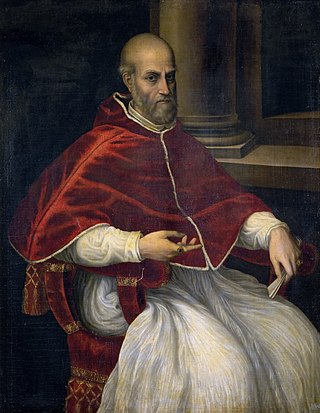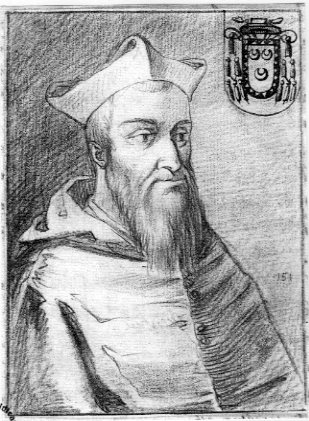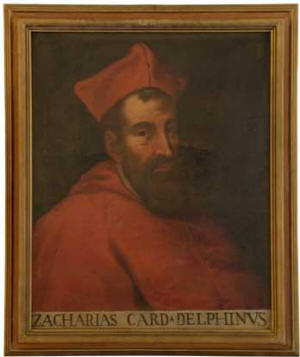This article relies largely or entirely on a single source .(August 2018) |

Fabio Mignanelli (died 10 August 1557) was an Italian Roman Catholic bishop and cardinal.
This article relies largely or entirely on a single source .(August 2018) |

Fabio Mignanelli (died 10 August 1557) was an Italian Roman Catholic bishop and cardinal.
Fabio Mignanelli was born in Siena ca. 1486, the son of Pietro Paolo Mignanelli and Onorata Saraceni. [1] He attended the University of Siena, becoming a doctor of both laws. [1] He then became a professor of law at the University of Siena. [1]
In 1533, he moved to Rome, becoming a consistorial advocate. [1] He was married to Antonina Capodiferro, the sister of Cardinal Girolamo Recanati Capodiferro and had a son. [1] After Antonia died, Mignanelli entered the church. [1] In 1537, he was sent as ambassador to the Republic of Venice to encourage Venice to break its alliance with the Ottoman Empire and to go to war against the Ottomans. [1] In October 1537, Pope Paul III sent him as ambassador to Charles V, Holy Roman Emperor to present him with the brief postponing the Council of Trent for a second time. [1] In spring 1538, he traveled to Nice with the pope to negotiate the end of the Italian War of 1536–1538; shortly thereafter, they traveled to Geneva to meet the emperor. [1] On 3 September 1538 he was appointed nuncio to Ferdinand, King of the Romans, holding this position until 1539. [1] In 1540, he became an auditor of the Roman Rota. [1] He was also a protonotary apostolic and the pope's domestic prelate. [1]
On 15 November 1540 he was elected Bishop of Lucera. [1] He was appointed governor and vice-legate in Bologna on 14 April 1541. [1] From 22 July 1543 to 2 August 1544 he was nuncio to the Republic of Venice. [1] He was present at the opening of the Council of Trent on 13 December 1545. [1] In 1546 he was vice-legate in Marche. On 20 September 1546 the pope sent him as nuncio to the emperor. [1] In 1548, he was vice-legate in Ascoli Piceno. [1] On 10 June 1551 he was appointed commissary of the Adriatic ports. [1]
Pope Julius III made him a cardinal priest in the consistory of 20 November 1551. [1] He received the red hat and the titular church of San Silvestro in Capite on 4 December 1551. [1] Shortly thereafter, he became Prefect of the Apostolic Signatura. [1] On 13 August 1552 the pope made him legate a latere to pacify Siena. [1] On 17 May 1553 he resigned the government of his diocese, becoming administrator of Grosseto; he resigned in favor of his nephew, Giacomo Mignanelli on 2 October 1553. [1] Pope Julius III then made him Prefect of the Papal States. [1]
He was a participant in both the papal conclave of April 1555 that elected Pope Marcellus II and the papal conclave of May 1555 that elected Pope Paul IV. [1]
He opted for the titular church of Santi Giovanni e Paolo on 12 June 1556. [1]
He died in Rome on 10 August 1557. [1] He was buried in Santa Maria della Pace. [1]

Pope Marcellus II, born Marcello Cervini degli Spannocchi, was head of the Catholic Church and ruler of the Papal States from 10 April 1555 to his death, 22 days later.

Alessandro Farnese, an Italian cardinal and diplomat and a great collector and patron of the arts, was the grandson of Pope Paul III, and the son of Pier Luigi Farnese, Duke of Parma, who was murdered in 1547. He should not be confused with his nephew, Alessandro Farnese, Governor of the Spanish Netherlands, grandson of Emperor Charles V and great-grandson of Pope Paul III.
Girolamo Dandini was an Italian cardinal and the first to serve as Cardinal Secretary of State in the Roman Curia. By the time of Pope Innocent X (1644–1655), the secretary of state was always a cardinal, and Pope Innocent XII (1691–1700) abolished the office of cardinal nephew in 1692.

The April 1555 papal conclave was convoked after the death of Pope Julius III. Cardinals at the conclave generally grouped themselves into three major factions, according to their alignment with the French House of Valois, the Hapsburgs, or Italian states that remained independent of both major Catholic powers. After preparing a conclave capitulation that compelled whichever cardinal was elected pope to maintain neutrality in European wars, cardinals from the Holy Roman Empire joined in supporting the French faction's candidate, Cardinal Marcello Cervini. Cervini was elected Julius's successor, and chose to maintain his baptismal (birth) name as his papal name, becoming consecrated as Marcellus II.

Miguel da Silva was a Portuguese nobleman, the second son of Diogo da Silva, 1st Count of Portalegre and of his wife Maria de Ayala, a Castilian noblewomen. He was ambassador of the king of Portugal to several popes, and papal ambassador to the Emperor and others.

The 1559 papal conclave was convened on the death of Pope Paul IV and elected Pope Pius IV as his successor. Due to interference from secular rulers and the cardinals' disregard for their supposed isolation from the outside world, it was the longest conclave of the 16th century.

The May 1555 papal conclave was convened on the death of Pope Marcellus II and elected Pope Paul IV as his successor.

Marcello Crescenzi was an Italian Roman Catholic bishop and cardinal.
Durante Duranti was an Italian Roman Catholic bishop and cardinal.
Girolamo Recanati Capodiferro was an Italian Roman Catholic bishop and cardinal.
Girolamo Verallo (1497–1555) was an Italian Roman Catholic cardinal and papal diplomat.

Fulvio Giulio della Corgna was a Tuscan Catholic bishop and cardinal.
Giovanni Andrea Mercurio (1518–1561) was an Italian Roman Catholic bishop and cardinal.
Giacomo Puteo (1495–1563) was a Spanish Roman Catholic bishop and cardinal.
Pietro Bertani (1501–1558) was an Italian Roman Catholic bishop and cardinal.

Giovanni Poggio was an Italian Roman Catholic bishop and cardinal. He is mainly known for the elaborate decorations he arranged for his residence, the Palazzo Poggi.
Giovanni BattistaCicala (1510–1570) was an Italian Roman Catholic bishop and cardinal.

Prospero Pubblicola Santacroce was an Italian Roman Catholic bishop and cardinal. He was active in Church affairs as a diplomat and prelate in Rome.

Zaccaria Delfino (1527–1584) was an Italian Roman Catholic bishop and cardinal. He served as bishop in modern-day Croatia, served as the papal nuncio to the Habsburg monarchy and participated in the Council of Trent before becoming a Cardinal in 1565. He was a member of the papal conclave that elected Pope Pius V and was named vice-protector of Germany.
Michele Della Torre (1511–1586) was an Italian Roman Catholic bishop and cardinal.